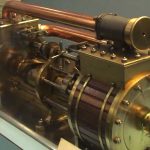The majority of steamers, both war and mercantile, built during the years 1850-60, were fitted with horizontal screw propeller engines worked with steam of from 20 to 25 lbs. pressure per square inch. The engines had jet injection condensers, and were not remarkable for economy of fuel, but they were much lighter, and occupied considerably less space, than the paddle-wheel engines that preceded them. The mean piston speed in this type of engine was generally about 400 ft. per minute, and the weight of machinery about 3 3/4 cwts. per I.H.P.
Surface condensation.
The adoption of surface condensation, which became general about 1860, formed a most important step in marine engineering. Its value consisted not so much in the economy effected by the avoidance of loss from the brining of boilers, as in the fact that by its eliminating the element of danger resulting from deposit of solid non-conducting matter on the heating surfaces, it rendered possible the use of higher steam pressures in marine boilers, and led eventually to the introduction of cylindrical boilersand compound engines.
When surface condensation was first introduced, the old flat-sided boilers, made to fit the section of the ship, were still retained, but were strengthened by fitting additional stays to enable them to carry steam pressures of 30 to 35 lbs. per square inch, and the majority of warships built during the years 1860-70 were fitted with surface-condensing engines worked with steam of this pressure. The piston speeds were also considerably increased, especially in the larger ships in which a long stroke could be obtained. With this type of engine the mean piston speeds varied from 500 to 665 ft. per minute.
To promote economy of fuel the cylinders were usually steam-jacketed, and made large enough to allow for considerable expansion at full power, and the boilers were fitted with superheaters. The average weight of the machinery of this type, including the water in boilers and condensers, was about 3 cwts. per I.H.P.
Compound or double expansion engines.
After the introduction of the surface condenser, attention was directed to the use of higher steam pressures and greater expansion of steam, as theoretical considerations showed that considerable gain could thus be effected. The result was that the steam pressure was increased from 30 or 35 lbs. to 60 lbs., while cylindrical boilers were fitted to safely carry the increased pressure, and the engine was changed to the compound type. Compound engines were fitted to nearly all warships from 1870 to 1885.
In this type of engine the expansion is conducted in stages; the steam, after being admitted to a small cylinder and expanding therein, is led to a larger cylinder, where it expands still further prior to exhaust, so that the stresses on the framing and journals are decreased and the loss from liquefaction of steam in the cylinders reduced to a minimum.
The following summary of its advantages is confirmed by experience :
1. Reduction of the maximum stresses on the framing, shafting, and bearings, and consequent reduction of weight and cost.
2. Increased regularity of turning moment, and consequent increased efficiency of the propeller in the water.
3. More economical use of the steam in the cylinders and consequent increase of power from a given expenditure of heat.
The working steam pressure in the Royal Navy with this type of engine was originally 60 lbs. per square inch. This has been gradually increased from time to time, till in about the year 1880 it was 90 lbs., while in the last of this type fitted the pressure was increased to 120 lbs. From the adoption of compound engines and higher steam pressures a considerable economy of fuel at once resulted. The gain in economy by the use even of the 60-lb. compound engines over the ordinary surface-condensing engines worked with steam of 30 lbs. pressure may be taken to be at least 30 per cent. This gain was well authenticated, and the average amounts claimed by the principal Engineers and Steamship Companies, in reply to questions by an Admiralty Committee in 1872, was 30 to 35 percent.


